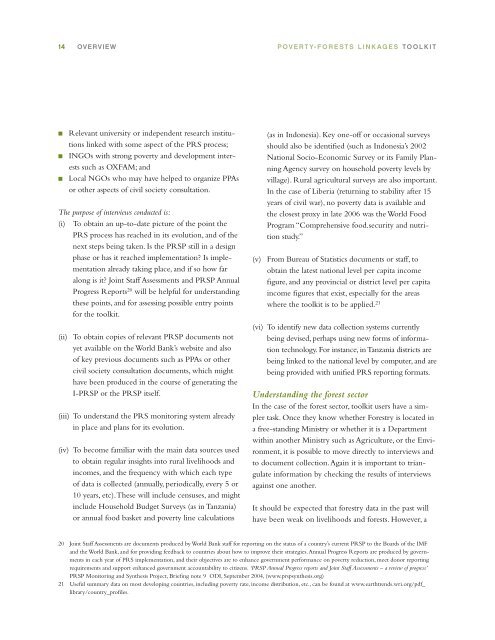Poverty-Forests Linkages Toolkit - IUCN
Poverty-Forests Linkages Toolkit - IUCN
Poverty-Forests Linkages Toolkit - IUCN
Create successful ePaper yourself
Turn your PDF publications into a flip-book with our unique Google optimized e-Paper software.
14 OVERVIEW<br />
POVERTY-FORESTS LINKAGES TOOLKIT<br />
n<br />
n<br />
n<br />
Relevant university or independent research institutions<br />
linked with some aspect of the PRS process;<br />
INGOs with strong poverty and development interests<br />
such as OXFAM; and<br />
Local NGOs who may have helped to organize PPAs<br />
or other aspects of civil society consultation.<br />
The purpose of interviews conducted is:<br />
(i) To obtain an up-to-date picture of the point the<br />
PRS process has reached in its evolution, and of the<br />
next steps being taken. Is the PRSP still in a design<br />
phase or has it reached implementation Is implementation<br />
already taking place, and if so how far<br />
along is it Joint Staff Assessments and PRSP Annual<br />
Progress Reports 20 will be helpful for understanding<br />
these points, and for assessing possible entry points<br />
for the toolkit.<br />
(ii) To obtain copies of relevant PRSP documents not<br />
yet available on the World Bank’s website and also<br />
of key previous documents such as PPAs or other<br />
civil society consultation documents, which might<br />
have been produced in the course of generating the<br />
I-PRSP or the PRSP itself.<br />
(iii) To understand the PRS monitoring system already<br />
in place and plans for its evolution.<br />
(iv) To become familiar with the main data sources used<br />
to obtain regular insights into rural livelihoods and<br />
incomes, and the frequency with which each type<br />
of data is collected (annually, periodically, every 5 or<br />
10 years, etc). These will include censuses, and might<br />
include Household Budget Surveys (as in Tanzania)<br />
or annual food basket and poverty line calculations<br />
(as in Indonesia). Key one-off or occasional surveys<br />
should also be identified (such as Indonesia’s 2002<br />
National Socio-Economic Survey or its Family Planning<br />
Agency survey on household poverty levels by<br />
village). Rural agricultural surveys are also important.<br />
In the case of Liberia (returning to stability after 15<br />
years of civil war), no poverty data is available and<br />
the closest proxy in late 2006 was the World Food<br />
Program “Comprehensive food.security and nutrition<br />
study.”<br />
(v) From Bureau of Statistics documents or staff, to<br />
obtain the latest national level per capita income<br />
figure, and any provincial or district level per capita<br />
income figures that exist, especially for the areas<br />
where the toolkit is to be applied. 21<br />
(vi) To identify new data collection systems currently<br />
being devised, perhaps using new forms of information<br />
technology. For instance, in Tanzania districts are<br />
being linked to the national level by computer, and are<br />
being provided with unified PRS reporting formats.<br />
Understanding the forest sector<br />
In the case of the forest sector, toolkit users have a simpler<br />
task. Once they know whether Forestry is located in<br />
a free-standing Ministry or whether it is a Department<br />
within another Ministry such as Agriculture, or the Environment,<br />
it is possible to move directly to interviews and<br />
to document collection. Again it is important to triangulate<br />
information by checking the results of interviews<br />
against one another.<br />
It should be expected that forestry data in the past will<br />
have been weak on livelihoods and forests. However, a<br />
20 Joint Staff Assessments are documents produced by World Bank staff for reporting on the status of a country’s current PRSP to the Boards of the IMF<br />
and the World Bank, and for providing feedback to countries about how to improve their strategies. Annual Progress Reports are produced by governments<br />
in each year of PRS implementation, and their objectives are to enhance government performance on poverty reduction, meet donor reporting<br />
requirements and support enhanced government accountability to citizens. ‘PRSP Annual Progress reports and Joint Staff Assessments – a review of progress’<br />
PRSP Monitoring and Synthesis Project, Briefing note 9 ODI, September 2004, (www.prspsynthesis.org)<br />
21 Useful summary data on most developing countries, including poverty rate, income distribution, etc., can be found at www.earthtrends.wri.org/pdf_<br />
library/country_profiles.

















